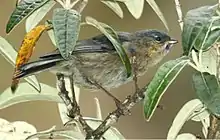Tit-like dacnis
The tit-like dacnis (Xenodacnis parina) is a small neotropical passerine bird found in southern Ecuador and Peru. In Spanish, it is known as Azulito Altoandino. It is found in Andean montane scrub forests from 3000 m to 4600 m elevation.
| Tit-like dacnis | |
|---|---|
 | |
| Adult Male, Cajas National Park, Ecuador | |
 | |
| Female - El Cajas Nat'l Park - Ecuador | |
| Scientific classification | |
| Kingdom: | Animalia |
| Phylum: | Chordata |
| Class: | Aves |
| Order: | Passeriformes |
| Family: | Thraupidae |
| Genus: | Xenodacnis Cabanis, 1873 |
| Species: | X. parina |
| Binomial name | |
| Xenodacnis parina Cabanis, 1873 | |
Adults reach 12.5 cm in length. Males are solid deep blue with dark eyes, bill, and feet. Females of all subspecies are duller, with rufous-brown underparts.
Taxonomy
The tit-like dacnis was formally described in 1873 by the German ornithologist Jean Cabanis from a specimen collected in the Andes of central Peru. Cabanis introduced the genus Xenodacnis and coined the binomial name Xenodacnis parina.[2][3] The genus name combines the Ancient Greek xenos meaning "different" or "unusual" with the genus name Dacnis. The specific epithet parina is from Modern Latin and means "tit like".[4] The tit-like dacnis is sister to a clade containing the four species now placed in the genus Idiopsar.[5][6]
Three subspecies are recognised:[6]
- X. p. bella Bond & Meyer de Schauensee, 1939 – southwest Ecuador and north Peru
- X. p. petersi Bond & Meyer de Schauensee, 1939 – central Peru
- X. p. parina Cabanis, 1873 – south Peru
References
- BirdLife International (2012). "Xenodacnis parina". IUCN Red List of Threatened Species. 2012. Retrieved 26 November 2013.CS1 maint: ref=harv (link)
- Cabanis, Jean (1873). "Xenodacnis parina n. sp". Journal für Ornithologie (in German). 21: 312, Plate 4 figs. 1, 2.
- Paynter, Raymond A. Jr, ed. (1970). Check-List of Birds of the World. Volume 13. Cambridge, Massachusetts: Museum of Comparative Zoology. p. 397.
- Jobling, James A. (2010). The Helm Dictionary of Scientific Bird Names. London: Christopher Helm. pp. 292, 410. ISBN 978-1-4081-2501-4.
- Burns, K.J.; Shultz, A.J.; Title, P.O.; Mason, N.A.; Barker, F.K.; Klicka, J.; Lanyon, S.M.; Lovette, I.J. (2014). "Phylogenetics and diversification of tanagers (Passeriformes: Thraupidae), the largest radiation of Neotropical songbirds". Molecular Phylogenetics and Evolution. 75: 41–77. doi:10.1016/j.ympev.2014.02.006.
- Gill, Frank; Donsker, David; Rasmussen, Pamela, eds. (July 2020). "Tanagers and allies". IOC World Bird List Version 10.2. International Ornithologists' Union. Retrieved 5 November 2020.
Clements, James F., and Noam Shany. A Field Guide to the Birds of Peru. Ibis Publishing, 2001.
